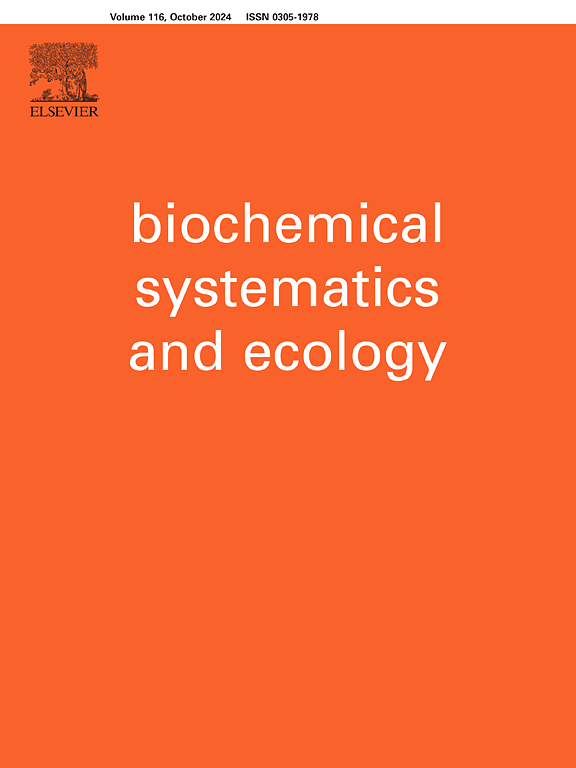Croton draco Schltdl. & Cham is a Latin American plant from the family Euphorbiaceae with therapeutic potential and ecological interactions: A review
IF 2
4区 生物学
Q4 BIOCHEMISTRY & MOLECULAR BIOLOGY
引用次数: 0
Abstract
Croton draco Schltdl. & Cham, a Latin American tree from the Euphorbiaceae family, is widely used in traditional medicine for treating wounds due to bioactive compounds like tannins, terpenes, and alkaloids. These compounds, found in various parts of the tree, including latex, bark, leaves, and flowers, contribute to its pharmacological value.
Data on the phytochemistry, biological activities, and ecological functions of C. draco were sourced from scientific databases, with an analysis of relevant articles, reviews, and case studies. The findings confirm that C. draco exhibits antibacterial, anti-inflammatory, and antihemorrhagic properties. Also, C. draco plays a crucial ecological role in agroforestry systems by promoting biodiversity and improving agricultural practices, especially in coffee cultivation. Furthermore, the tree supports ecosystem health through mutualistic relationships with insects, fungi, and birds, contributing to sustainable agricultural practices.
This study examines the relationship between the bioactive compounds and the traditional medicinal uses of C. draco, emphasizing both its therapeutic value and ecological significance. Nevertheless, in the future, the curative effects will be validated with new scientific studies.

Croton draco Schltdl。& Cham是一种拉丁美洲大戟科植物,具有治疗潜力和生态相互作用:综述
Croton draco Schltdl. & Cham 是大戟科大戟属的一种拉丁美洲树木,由于含有单宁、萜烯和生物碱等生物活性化合物,在传统医学中被广泛用于治疗伤口。有关 C. draco 植物化学、生物活性和生态功能的数据来自科学数据库,并对相关文章、评论和案例研究进行了分析。研究结果证实,龙脑香具有抗菌、消炎和止血的特性。此外,龙脑香在农林系统中发挥着重要的生态作用,促进了生物多样性,改善了农业生产方式,尤其是在咖啡种植中。本研究探讨了 C. draco 的生物活性化合物与传统药用之间的关系,强调了其治疗价值和生态意义。不过,未来将通过新的科学研究来验证其治疗效果。
本文章由计算机程序翻译,如有差异,请以英文原文为准。
求助全文
约1分钟内获得全文
求助全文
来源期刊

Biochemical Systematics and Ecology
生物-进化生物学
CiteScore
3.00
自引率
12.50%
发文量
147
审稿时长
43 days
期刊介绍:
Biochemical Systematics and Ecology is devoted to the publication of original papers and reviews, both submitted and invited, in two subject areas: I) the application of biochemistry to problems relating to systematic biology of organisms (biochemical systematics); II) the role of biochemistry in interactions between organisms or between an organism and its environment (biochemical ecology).
In the Biochemical Systematics subject area, comparative studies of the distribution of (secondary) metabolites within a wider taxon (e.g. genus or family) are welcome. Comparative studies, encompassing multiple accessions of each of the taxa within their distribution are particularly encouraged. Welcome are also studies combining classical chemosystematic studies (such as comparative HPLC-MS or GC-MS investigations) with (macro-) molecular phylogenetic studies. Studies that involve the comparative use of compounds to help differentiate among species such as adulterants or substitutes that illustrate the applied use of chemosystematics are welcome. In contrast, studies solely employing macromolecular phylogenetic techniques (gene sequences, RAPD studies etc.) will be considered out of scope. Discouraged are manuscripts that report known or new compounds from a single source taxon without addressing a systematic hypothesis. Also considered out of scope are studies using outdated and hard to reproduce macromolecular techniques such as RAPDs in combination with standard chemosystematic techniques such as GC-FID and GC-MS.
 求助内容:
求助内容: 应助结果提醒方式:
应助结果提醒方式:


